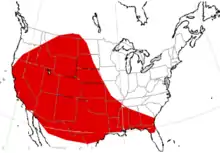Temnocyoninae
The Temnocyoninae are an extinct subfamily of medium-sized bear dogs endemic to North America that lived during the Early Oligocene to Early Miocene about 30.8-20.43 million years ago (Mya) existing for around 10 million years.[1]
| Temnocyoninae | |
|---|---|
| Scientific classification | |
| Kingdom: | Animalia |
| Phylum: | Chordata |
| Class: | Mammalia |
| Order: | Carnivora |
| Family: | †Amphicyonidae |
| Subfamily: | †Temnocyoninae Hunt, 1998 |
| Genera | |
 | |
| Range of temnocyonines based on fossil record | |
Fossil distribution
The first fossils are recorded in North America at Logan Butte in the John Day beds of Oregon 29–29.5 Mya, in the Sharps Formation of the Wounded Knee area, South Dakota 28–29.5 Mya, and in the Gering Formation at Wildcat Ridge, Nebraska 28.3 Mya. These early temnocyonines attained the size of coyotes or small wolves (15–30 kg), and are identified by a uniquely specialized dentition. The last documented occurrences of temnocyonines are found in sediments in northwest Nebraska and southeastern Wyoming.[2]
References
- PaleoBiology Database: Temnocyon
- Hunt, Robert M, Jr. (2004) "Global Climate and the Evolution of Large Mammalian Carnivores during the Later Cenozoic in North America" in Cenozoic Carnivores and Global Climate by Robert M. Hunt, Jr.
This article is issued from Wikipedia. The text is licensed under Creative Commons - Attribution - Sharealike. Additional terms may apply for the media files.